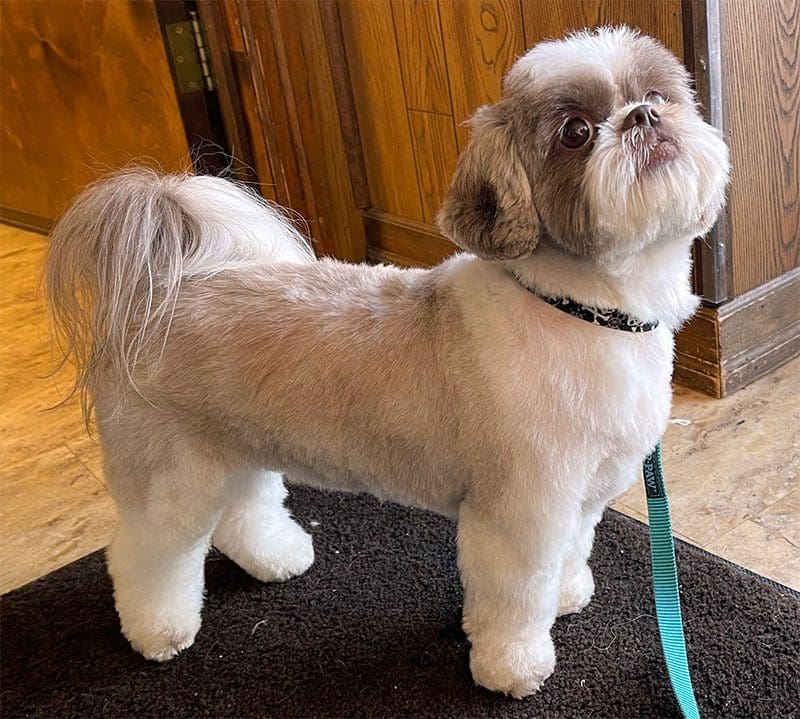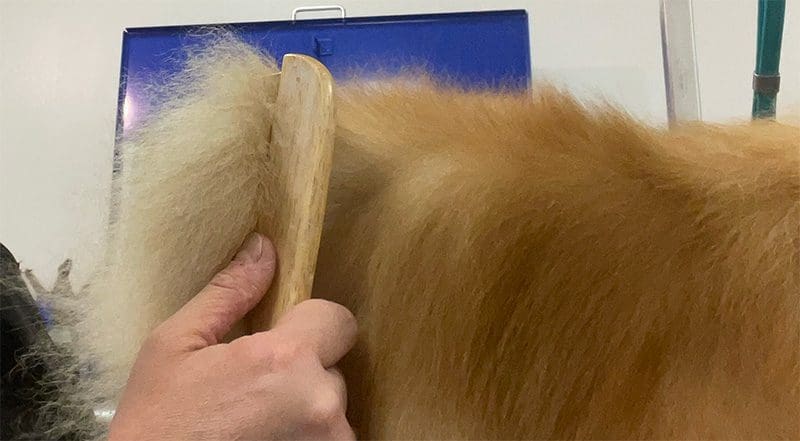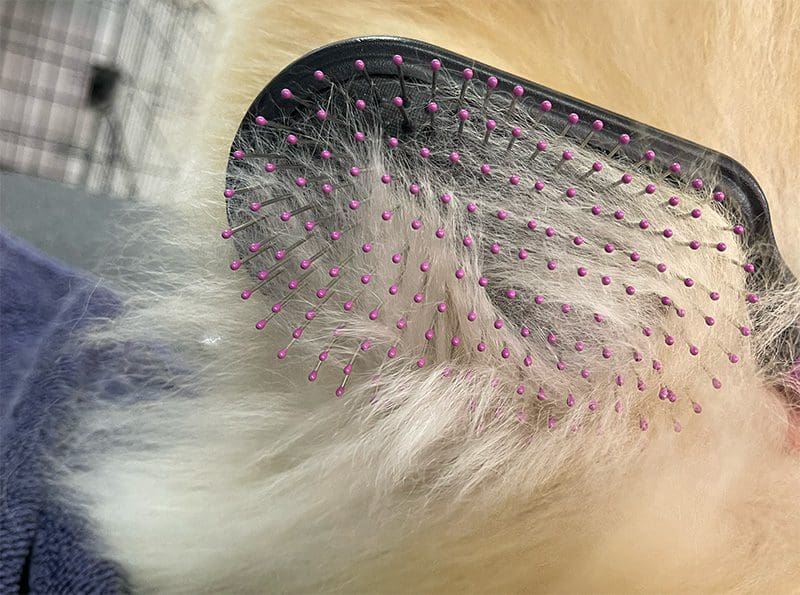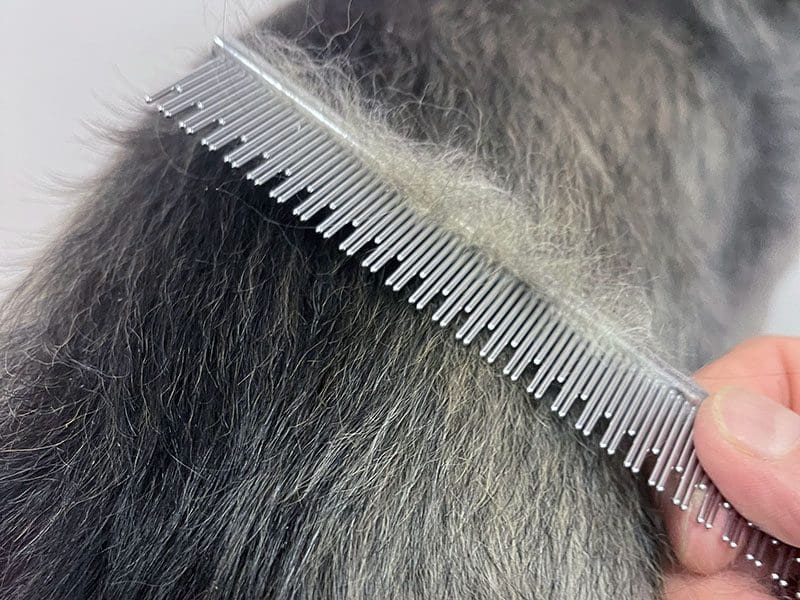
As a professional dog groomer, I am often asked what the best dog brush is. This seems like an easy enough question, but the truth is that your dog’s coat is actually a very complex topic.
In order to simplify things, I wrote this article so that you can easily find healthy ways to brush your dog.
The good news is that there are several quality products and brushing strategies that you can use at home for a variety of situations.
Please read on to identify the best dog brush that will work for your dog.
In this Article We Cover:
- Why is it So Hard to Find the Best Dog Brush?
- Best Dog Brushes: Products and Brushing Tips
- Furminator Dog Brush: Is it a Dog’s Best Friend or Foe?
- Dog Breeds and Coat Types: A Deep Dive
- Healthy Skin. Healthy Coat. Happy Dog!
Why is it So Hard to Find the Best Dog Brush?
Why doesn’t there seem to be a straight answer to such a simple question: What is the best dog brush?
Well, as it turns out, the question isn’t as simple as it seems. The best dog brush for your particular dog needs to get the best results with minimal effort on your part.
And it’s very important that your dog doesn’t hate the entire process.
In order to determine the best dog brush to use, you need to know what kind of coat your dog has.
There are 15 different dog coat types, but luckily, you just need to know that these 15 coat types are separated into two main groups: fur or hair.
Fur Covered Dogs
About 80% of dogs belong to the fur group. Many of the fur covered dogs have what is known as a double coat. Members of the furred group can also be considered wire coated, flat coated, and even hairless.
Furred dogs have an undercoat for insulation and a top coat for protection of the undercoat and skin. The undercoat is what we find on our couches and floors.
This is why it’s important to use dog brushes that address the dead undercoat while leaving the top coat intact.
Hair Covered Dogs
The other group, hair covered dogs, were bred for long, beautiful, and sometimes protective coats. Dogs such as Poodles and Komondors were bred to have coats for protective purposes.
The hair covered group also includes our beloved lap dogs such as Shih Tzu, Maltese, Bichon Frise, and Yorkshire Terriers. Hair covered dogs require frequent professional-level attention.
The main difference between the furred dogs and the hair covered dogs is that the coat of the furred dogs grows to a certain length and then it dies and sheds off. Conversely, the coat of hair covered dogs will grow and grow and grow until it is cut.
Finding the best dog brush for your dog is a process. You need to take an educated guess as a starting point and then spend time brushing your dog to see how it goes.
If possible, it’s good to ask your dog groomer for feedback on how the brush is performing for your dog.
Read on for my recommendations for the best dog brushes of 2023!
Best Dog Brushes: Products and Brushing Tips

My clients will often ask me what products I buy for my own pets. I signed up for the Amazon Associate Program so that I can include Amazon product links in this article.
If you click on a link below and make a purchase, I will receive a small commission at no extra cost to you. I truly appreciate this as it helps me to continue my mission to provide pet wellness education. Thank you so much!
Here is a listing of the best dog brushes I’ve found in 2023.
Best Dog Brushes for Short, Smooth Haired Dogs
Example Dog Breeds: French Bulldog, Beagle, Boxer, Dachshund, German Short Haired Pointer, Short Haired Chihuahua, Great Dane, Dobermann, Boston Terrier, Coonhound, Weimaraner, Dalmatian, Basset Hound, Staffordshire Terrier.
For short, smooth haired dogs, like a Dalmatian, Bassett Hound, or Staffordshire Terrier, the Kong Zoom Groom and the Raw Paws Pet Hand-Held Rubber Tipped Pin Brush are my go-to when I need a good deshedding brush for short haired dogs.
These brushes are gentle and won’t scratch the delicate skin of thin-coated breeds. I work from head to tail, in the direction the coat grows using firm, but careful strokes.
For shine, smoothing, and oil distribution, the Bamboo Groom Palm-Held Brush helps restore the all-important protective oils for healthy, moisturized skin and coat.
A good groomer will gently shampoo, but especially condition these coats to make sure they aren’t prone to dryness and rashes.
Best Dog Brushes for Medium, Flat, and Wire-Type Double-Coat Dogs
Example Dog Breeds: Border Collie, Labrador Retriever, Golden Retriever, German Shepherd, Rottweiler, Airedale, Corgi, Cocker Spaniel, West Highland White Terrier (Westie), English Springer Spaniel, Brittany, Australian Shepherd, English Setter.
For double, flat, and wire-type coats, such as Golden Retrievers, German Shepherds, and Airedales, a pin-type brush like the Boshel Dog Hair Brush 2 in 1 Brush works wonderfully to gently loosen dead undercoat.

After loosening with a pin brush, I love the Omnipet Leather Brothers Cocker/Poodle Comb to find packed dead undercoat. Who would’ve thought that you could find the best deshedding brush in a comb?
The wide teeth will slide through a dense coat and when you feel it catch a bit, you can use it to gently lift the clogged hairs from the rest of the healthy coat.

Once I’ve gone over the whole dog, I’ll switch to my workhorse tool, the Andis Steel Pet Comb, which comes in two sizes. I keep both sizes on hand since there are delicate parts that you might want a smaller tool to reach and the 10 inch comb is great for larger, flat areas.
A proper professional groom every 4-8 weeks will make sure shedding is kept to manageable levels at home. Proper conditioning will keep skin happy and also minimize matting on the feathered breeds.
Best Dog Brushes for Long or Heavy Double-Coat Dogs:
- Andis Pet Large Pinned Brush
- Artero Double Flexible Slicker Brush
- PETPAWJOY Slicker Brush
- Conairpro Grooming Rake and Shedding Tool
Example Dog Breeds: Husky, Bernese Mountain Dog, Newfoundland, Rough Coated St. Bernard, Great Pyrenees, Rough Coated Collie, Pomeranian, Chow Chows, Shetland Sheep Dog (Sheltie), Alaskan Malamute, Shiba Inu, Old English Sheepdog.
For long double-coats, like Saint Bernards and Rough Collies, and the Nordic breeds, like Huskies and Malamutes, you’ll want to avoid the fine toothed combs!
These coats tend to be too dense and using fine toothed combs will pull on healthy, solidly rooted hair which will hurt the dog. I start with a long-pinned brush like the Andis Pet Large Pinned Brush to loosen the coat and see where any trouble spots are hiding.
Sometimes, I may have to give a good spritz of conditioner and then work on any impacted coat areas with the Artero Double Flexible Slicker Brush. The flexible brush head has some give and is gentler on the dog’s skin and coat.
I use a picking motion while isolating sections of coat to make sure I don’t scrape the dog’s skin which can introduce dirt and bacteria.
Best Dog Brush for Small Dogs
For small dogs, I love the PETPAWJOY Slicker Brush for shedding since the coated tips and smaller size is comfortable for the dog and the groomer.
Deshedding Brush for Dogs
For deshedding, the poodle comb works nicely if you work methodically. On the large and medium dogs, an ergonomically designed rake like the Conairpro Grooming Rake and Shedding Tool is much more efficient for the groomer.
You may need to split the brushing into several sessions over a few days to be fair to the dog and yourself! Groomers have developed repetitive motion injuries from grooming large dogs with these heavy coats!
The best way to deshed any dog is to visit your knowledgeable groomer and ask for a proper bath, deshed, and blow out with a high velocity dryer.
This method is gentlest and most thorough, without the tugging and breakage that can result from hours of brushing.
Best Dog Brushes for Lovely Long Coated Dogs:

- Mars Professional Grooming Brush
- Wetbrush Original Detangler Hairbrush
- Tropiclean Tangle Remover
- Wahl Dual Level Slicker
- Andis Steel Pet Comb
Example Dog Breeds: Doodle, Poodle, Yorkshire Terrier (Yorkie), Shih Tzu, Maltese, Havanese, Bichon Frise, Komondor, Afghan Hound, Lhasa Apso, Portugese Water Dog, Puli.
For the lovely long coated dogs, whether a Poodle or Yorkie, the goal is a clean, well-conditioned coat.
These coats don’t shed like the other coats do, which means dead undercoat (which they do have!), dirt, oils, and pollution can be held against the dog’s hair and skin. This will sometimes lead to irritation and quite often leads to matting.
If your dog is matted, make sure a groomer shaves under the mats to remove them. This allows you to start the brushing process with a clean slate!
Your dog will thank you for not putting him through the arduous and oftentimes uncomfortable dematting process.
My Favorite Dog Brush
The Mars Professional Grooming Brush is wonderful, but my absolute favorite, particularly for starting any dog out with the brushing process, sensitive dogs, or even for my own hair, is the Wetbrush Original Detangler Hairbrush. This brush is perfectly gentle and foolproof. I love it.
Brush your long haired dog as you would your own hair. Roll sections between the bristles to smooth them and make sure to work all the way down to the skin.
Don’t forget the friction areas, like the armpits and ears, and areas that get wet often, like between the toes.
When you find a tangle, you can give a spritz of conditioner, like Tropiclean Tangle Remover and pick at it with a soft slicker, such as the Wahl Dual Level Slicker.
When you’ve brushed an area out, use the poodle comb and then the Andis Steel Comb to check down to the skin for mats. You should work from the widest, or coarsest comb to the finest.
Best Professional Dog Grooming Brushes

- Chris Christensen Slicker Brush
- Chris Christensen Combs
- Shernbao High Velocity Professional Dog Grooming Dryer
- Original Happy Hoodie for Dogs and Cats
Professional level tools are often more durable and have a higher quality finish. If you’re looking to have an even easier time keeping your dog’s coat mat-free or his shedding to a minimum, it may be worth the extra cost.
Chris Christensen Slicker Brushes are often a favorite among groomers for the way they decrease the effort in fluffing and detangling a coat.
The coral colored version of the brush (pictured above) has more pins than the black version. I’ve found that opinions tend to vary over which one is preferred. It depends on the density of the coat you’re working on.
Slickers need to be used carefully, as they can cause scratches to the skin and on the hairs themselves. It’s important to use a pat-and-pull technique when you’re using the slicker.
The Chris Christensen Combs are also excellent.

The Deshedding Power of a Quality Bath followed by High Velocity Drying
My favorite tool for deshedding and detangling is actually a quality bath and conditioning followed by high velocity drying.
All dogs should be introduced to the dryer gradually. A great dryer to start out with is the Shernbao High Velocity Professional Dog Grooming Dryer.
The variable speed allows you to keep the setting low until the dog is more comfortable. You should always use a Original Happy Hoodie for Dogs and Cats to protect the dog’s sensitive ears. This will also help to keep the dog calmer.
Never aim the dryer at the dog’s face or body orifices. Extra care should be taken with brachycephalic or smooshy faced dogs. They are more prone to eye injuries and breathing issues while being groomed.
The high velocity dryer is the gentlest and most effective way to remove dead coat without scraping the skin and hair for hours with a brush.
Make sure to wear a mask if you’re prone to breathing issues. Additionally, remember to clean the filters of the dryer regularly. Otherwise, the unit can overheat when it sucks in the hair that is dislodged.
Once I blow the standing water off a dog, I’ll towel dry them by squeezing the coat with a fluffy towel. I don’t rub the coat aggressively.
Once they’re as dry as possible with the towel you can start the dryer again and use a brush as you work to make sure the air is able to lift the dead coat from the skin.
Give an extra spritz of “leave in” conditioner and then shine them up with a comb for long haired breeds or a rubber curry for short haired breeds and Voila!
Beyond Dog Brushes:

- Nature’s Specialties Waterless Shampoo Plum Silky
- Bone Dry Towel
- Stewarts Freeze Dried Dog Treats
- Eqyss Avocado Mist Pet Conditioner
Example Dog Breeds: All dog breeds!
Any coat should be relatively clean if you’re planning to brush it.
Failing a proper bath and dry by a groomer, you’ll want to use a waterless bath such as Nature’s Specialties Waterless Shampoo Plum Silky. It’s gentle and tearless which makes it perfect for use on a damp cloth to wipe dirt, pollution, and excess skin oils from the surface of the dog’s coat.
A terry cloth like the Bone Dry Towel makes a perfect pet wipe. It removes grime so you don’t wind up brushing it further into the dog’s coat and even his skin. This also reduces static which is helpful because static can cause the dead coat to resist being whisked away.
You should practice gently handling your dog to find out where brushing may make him sensitive or uncomfortable. Giving treats as you work, like Stewarts Freeze Dried Dog Treats, is a great way to show your dog that brushing is a positive experience that he can look forward to.
You can also mist your pet lightly as you work with a quality conditioning spray like Eqyss Avocado Mist Pet Conditioner. This will smooth damaged hair and minimize static and tangles.
When applying it to your dog’s face, always spray your hand or a cloth first rather than directly spraying near their eyes, nose, or mouth.
Additionally, I never apply fragrances close to a dog’s sensitive nose.
Dog Brushing Tips:
If you discover any skin issues or your dog seems snappy or uncomfortable, you should consult your vet before proceeding with any grooming routine.
After the vet says your dog is healthy, you can ask a force-free trainer or dog groomer to help teach you how to introduce your dog to brushing without making them more afraid or uncomfortable.
Always brush your dog in the direction the coat grows to prevent damaging the delicate structures of the skin. Stop brushing if you encounter matting, or tangles, since those should be addressed by a professional.
Many dogs are injured accidentally by well-meaning owners trying to cut matted fur or hair. Once the tangles are shaved out safely, you can continue with your brushing routine more regularly. This will help to prevent the mats from happening again.
Always stop before your dog seems grumpy or tired of your session. Remember to keep your grooming sessions happy, and full of tasty treats to encourage your dog to participate.
Be careful that you aren’t training your dog that grumpiness will end a session. However, punishment should never be used to stop a pet from showing that they aren’t happy.
Instead, stop your session, and seek out a reward-based trainer who uses science-backed methods to show you how to improve your pet’s experience with grooming.
Furminator Dog Brush: Is it a Dog’s Best Friend or Foe?

While the Furminator Dog Brush is a very popular and well marketed brush that is often brought to me by clients, it is notorious for shredding your dog’s top coat while not removing the dead undercoat.
The Furminator was originally designed around what is called a carding tool. Carding tools require a careful, trained technique. The Furminator does not allow for the proper angle or technique to be used to avoid damaging the coat.
The pile of fur resulting from the use of the Furminator is from cutting healthy and dead coat alike instead of properly pulling dead coat from the root.
Dog Breeds and Coat Types: A Deep Dive

A dog’s skin and its protective coat work together to create an amazing organ that helps to keep your dog happy and healthy.
There are 15 different dog coat types that are separated into two main groups: fur or hair.
Fur Based Coats:
Fur covered dogs make up about 80% of dogs. The fur coats grow only as long as their DNA tells them to.
Some will grow longer than others, such as a puffy Pomeranian or bear-like Newfoundland. But in every case, the coat will only grow to a certain length and then it will stop. And after it stops growing, it will shed.
Short haired, and even dogs that are considered hairless, like the Chinese Crested and Xoloitzcuintli, are included in the “furred” group. Their coats also have a predetermined length.
Hairless and short-haired, smooth coated dogs, such as Coonhounds, Weimeraners, and Boxers need the most protection for their skin. This is because their fur is often not thick or long enough to provide much protection.
Because of their lack of coat, they will produce a thicker sebum. The sebum is a protective oil on the dog’s skin.
The oldest breeds, like Huskies, Malamutes, Pomeranians, and Samoyeds are also double coated. They are often called snow dogs or Nordic breeds.
These dogs have what’s called a primitive coat, which can have two layers of undercoat beneath the external coat. This means that they are actually triple coated. The bottom most layer is called the tertiary coat and it is used for extra protection from the cold.
It’s best to always use quality deshedding tools and techniques. It is also good to establish a routine with a knowledgeable groomer for healthy skin and to control shedding.
Hair Based Coats:
Hair is the other coat group and makes up about 20% of dogs. The hair covered dogs were bred for long, beautiful, and in some cases protective coats.
Many of our beloved lap dogs such as Shih Tzu, Maltese, Bichon Frise, and Yorkshire Terriers are in the hair group.
A hair coat will grow and grow and grow until it is cut. These coats need frequent, professional-level attention from a grooming professional or their owners need to seek out proper grooming training.
Hair coats are prone to tangling and breakage if they’re not cared for properly. Also, they are less protective than the more natural fur type. This can add to the likelihood that a hair coated dog will experience skin problems.
An unhealthy hair coat can lead to a maintenance nightmare for you and your dog.
Some of the most unique dog breeds have hair coats rather than fur. Examples include the Corded Komondor whose coat can be trained to grow cords to form a suit of armor, the elegant Afghan Hound, and the very popular Doodle mixes.
Some dogs, including the Doodles, have a combination of coat types which complicates coat care and maintenance needs.
Healthy Skin. Healthy Coat. Happy Dog!
Shaving coats short is not a substitute for proper coat care. Shaving any dog too short, and for some breeds any shaving at all, will cause skin issues and improper coat regrowth.
A healthy coat will give your dog protection from the sun and extreme temperatures. Additionally, it provides a buffer from environmental stressors.
Nothing makes your dog feel quite as good as a clean, healthy skin and coat. You want your dog to be happy and at his absolute best. That means taking the time to consider the best grooming routines for your particular dog.
Finding the best dog brush for your dog is a process. You need to take an educated guess as a starting point. Then, spend time brushing your dog to find what works best.
If possible, it’s great to connect with a local dog groomer for professional assistance on keeping your dog’s coat healthy. A dog groomer can assist you with the maintenance your dog’s coat deserves that can’t be solved by brushing alone.
I hope this guide was helpful and you are ready to find the best dog brush for your dog! Here’s to many enjoyable grooming sessions in your future!
Ready for More Dog Articles?
Please check out our Dog Blog for a full listing of all of our dog articles!
Join Our Mailing List!
We hope you enjoyed reading this article! The Absolute Animal Care Blog features articles that contain our best recommendations for dog and cat wellness, training strategies, and products.
Please join our mailing list to receive updates when new articles are released!
Close Up Photo of Dog in Furminator Dog Brush Section by Torrie Sartor and Erica Budzinski
Dog Photo in Fall Foliage by Torrie Sartor and Erica Budzinski
All Other Dog and Dog Brush Photos by Absolute Animal Care
